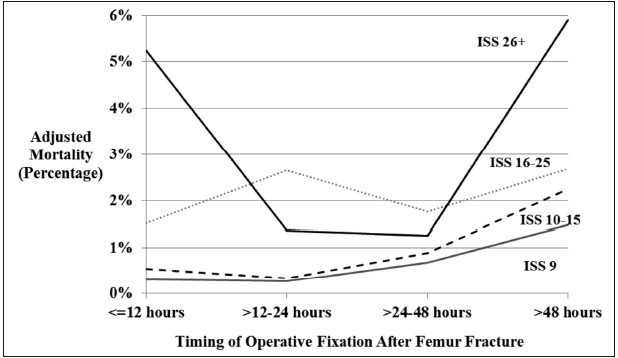
Sat., 10/6/12 General Interest, PAPER #96, 1:15 pm OTA-2012
Optimal Timing for Femoral Shaft Fracture Fixation Depends on Injury Severity Score and Age
Sara C. Graves, MD; Robert Victor Cantu, MD; Kevin F. Spratt, PhD;
Dartmouth Hitchcock Medical Center, Lebanon, New Hampshire, USA
Purpose: Optimal surgical timing for definitive treatment of femur fractures in severely injured patients remains controversial. This study was performed to examine in-hospital mortality for patients with femur fractures with regard to surgical timing, ISS, and age.
Methods: The National Trauma Data Bank–version 7.0 was used to evaluate in-hospital mortality for patients presenting with unilateral femur fractures relative to timing, ISS, and age, adjusting for patient health, injury, and personal demographics. Patients were stratified into 4 groups by surgical timing (ST1 ≤12 hours, ST2 >12-24 hours, ST3 >24-48 hours, and ST4 >48 hours to 30 days) and 4 groups by ISS (ISS = 9, 10-15, 16-25, and 26+). Chi-square tests evaluated baseline interrelationships of timing and ISS with other predictors. Poisson regression estimated unadjusted and adjusted in-hospital mortality rates and relative risks (RR) associated with timing and ISS classification.
Results: 7540 patients met inclusion criteria with a 1.4% overall in-hospital mortality rate. For patients with an isolated femur fracture, delaying surgery >48 hours was associated with a 5 times greater mortality compared to surgery within 12 hours (adjusted RR 4.8 [95% confidence interval, 1.6-14.1]) The only group that had lower mortality with a delay in surgery was the most severely injured patients (ISS 26+), who had 4 times lower mortality if surgery was performed between 12 and 48 hours rather than being performed within the first 12 hours (adjusted RR 4.2 [95% confidence interval, 1.0-16.7], adjusted absolute mortality rates of 5.2 vs. 1.3%). The association between higher mortality rates and surgical delay beyond 48 hours was even stronger in elderly patients.
Figure 1. Adjusted Mortality Rates by Injury Severity Score and Timing of Operative Fixation after Femur Fracture.

Conclusion: This study supports the work of prior authors who reported that early definitive fixation of femur fractures is beneficial, but also is consistent with more recent studies recommending at least 12 to 24 hours delay in fixation in severely injured patients to promote better resuscitation. Delay of definitive care beyond 48 hours was associated with higher mortality rates, particularly in the elderly.
Alphabetical Disclosure Listing (808K PDF)
• The FDA has not cleared this drug and/or medical device for the use described in this presentation (i.e., the drug or medical device is being discussed for an “off label” use). ◆FDA information not available at time of printing. Δ OTA Grant.